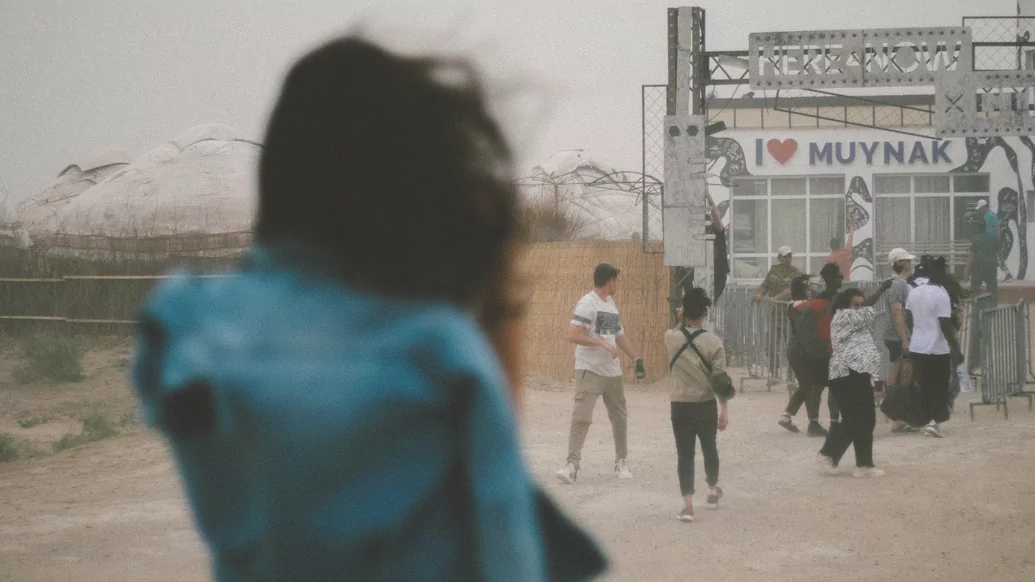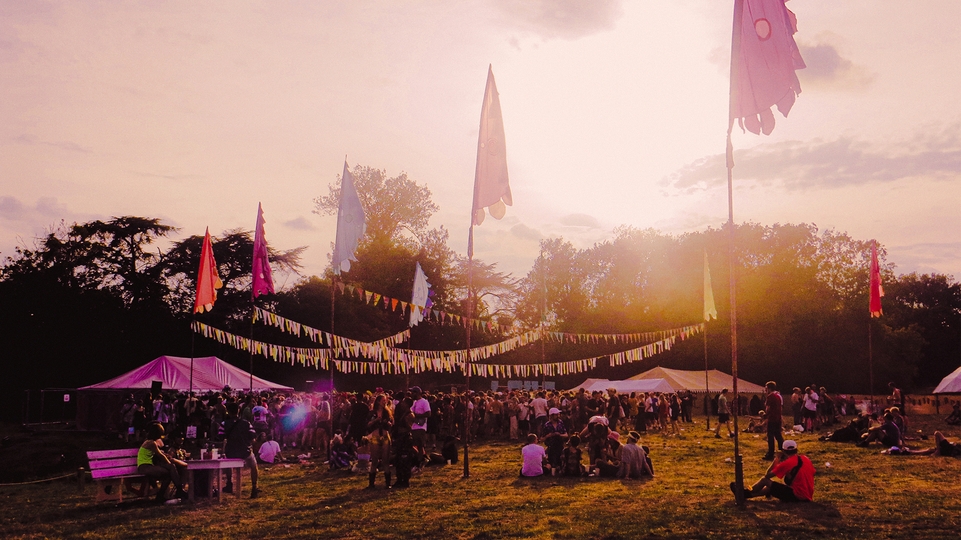
Uzbekistan’s Stihia festival, where environmental and social activism meet cutting-edge electronic music
Claire Francis travels to Stihia festival to find an event that serves as a vital platform for emerging DJs from within Uzbekistan, as well as supporting local sustainable development
In the desert in a remote corner of Uzbekistan, where rain is infrequent and water is scarce, an unexpected and ferocious downpour is unfolding. It’s the first night of Stihia Festival, the electronic music, arts and science festival whose name roughly translates as ‘force of nature’. As the deluge intensifies and thunder rumbles overhead, it seems as though Mother Nature is issuing a supernatural admonition in this parched place, that was once home to the fourth largest lake in the world.
Despite the strengthening storm, Goa-based DJ, Kaleekarma, is keeping the good vibes flowing. Against the backdrop of a now incongruous lighthouse, a large crowd of enthusiastic dancers is enjoying her grooving, percussive set, which she delivers with poise and a steady hand. As she leans into the quivering bassline and propulsive drums of SUCHI’s ‘Seher’, the heavens respond with a flash of pink and a sudden, brilliant fork of lightning. A huge collective cheer erupts from the dancefloor. Like some cosmic signifier of the power of the elements, it’s a poignant reminder of both the beauty and destruction that occurs when humans co-exist with the natural world.
Stihia takes place in Muynak, a small township in northern Karakalpakstan, an autonomous republic in Uzbekistan more than 1,300km away from the country’s capital of Tashkent. Muynak was once a port city, flanked by the Aral Sea and home to a flourishing fishing community. But in the 1960s, Soviet irrigation projects began diverting the rivers that fed the sea to support agricultural production, causing the lake to dry up and the local economy to collapse.
A ship graveyard lies adjacent to the festival site. Dotted with the rusting hulks of abandoned vessels, it makes a striking backdrop for those all-important DJ photos, but it’s also a grim reminder of how devastating the decline of the sea has been for the region. The seabed has been replaced by miles of sand and a scattering of wind-battered shrubs, and the arid landscape now has the dubious honour of being the world’s youngest desert. Conceived in 2018 by lawyer, DJ and techno aficionado Otabek Suleimanov, Stihia’s mission is to support sustainable development in Muynak and raise awareness of what is now considered the most acute environmental problem in Central Asia.

“The ‘act of God’ that happened on the first day almost completely destroyed the entire event,” says Suleimanov via video call from Tashkent a week after the festival, once the dust has literally and metaphorically settled. He’s referring to the intense rainfall, plus the swirling sandstorms and fierce winds that also batter Stihia’s rustic open-air stages on the opening Friday. As a result, two of the festival’s three stages are shut down on the first night, with some performances — such as Polar Inertia’s live set — cut short, and other artists unable to perform altogether.
“We didn’t expect rain of that magnitude,” he admits. “The techno stage burned out, we had to swap the line-up and we didn’t know what the weather conditions would be like for the following days.”
“It is usual to have rain in May, but not such strong rain and not for such a long period,” explains festival co-organiser, Sanjar Halmuradov. “Usually the rains are very short and not very heavy and the sandstorms only last for an hour or two. The rain is usually good for us because it will cool down, there will be no dust, and people will chill. But at least this was good for the vegetation and it’s good for the desert.”
“After the first night we were sitting at the lighthouse at 4am and we were on the brink of cancelling the entire event,” reveals Suleimanov. “All of a sudden, there was a woman — she was a bit drunk, and she came out of nowhere, to be honest — and she heard our conversation. She lay on the floor and started shouting that we could not cancel, because it would kill the entire concept. That was a sign for us to continue,” he laughs. “We somehow managed to swap the stages and reshuffle the entire line-up.”

“In Uzbekistan, if you are lost and stop someone to ask for directions, we won’t just point out the way to go. We will walk with you, or invite you to our house, share a meal and offer you a place to stay for the night”
The elemental forces that present so many obstacles for this fourth edition of Stihia are also responsible for the public health catastrophe that has plagued this part of Uzbekistan since the sea began to shrink. The little remaining water in the area has toxic levels of salinity, and there is also severe pollution caused by agricultural chemical runoff, both of which have given rise to chronic acute illnesses among the community.
To hold an electronic music festival — the largest event of its kind in Central Asia — in response to an ecological disaster might seem like an odd remedy, but Suleimanov is driven by “a love of electronic music, and the unstoppable desire to make something unusual in Uzbekistan,” he explains.
“This is not just a gigantic party. If we wanted to just do that, we could do it in Tashkent, and trust me, it would be a hundred times easier to do it there. But we do it in Muynak purposefully, because this is one of the most devastated parts of the country.
“We don’t know how to attain sustainable development yet, precisely, other than making noise,” he continues. “The economic effect is currently short-term, but it’s clearly there. For the taxi drivers, the cafés, the shops, groceries, hotels, guest houses — everyone that visits is spending cash. If we had the resources, we would run the festival every month. But at least as a result, the government is now paying more attention to this area of the country.”
Given the isolated location, getting to Stihia is an adventure in itself. It’s possible to take a flight from Tashkent to the westerly cities of Nukus or Urgench, and then continue by car to Muynak, but DJ Mag opts to take a slower, more scenic and environmentally sustainable route via overnight train. Interestingly, the festival is opening up tourism within the country, according to Halmuradov.
“Before, you would find more people from Tashkent who have been to Turkey, or Dubai, or Thailand, than places like Samarkand or Muynak. If you would say, let’s go to Muynak, people would say it’s dangerous, it’s a dried up sea full of fertilisers, it’s not good for your health — they will find many, many reasons not to visit.
“So we have to encourage people to understand that it’s safe and that once in a lifetime they have to make this trip — to see how luxuriously they live in Tashkent and compare their lifestyles with the locals, to gain that perspective.”

A quick and comfortable bullet train from Tashkent brings us to Samarkand in a little over two hours. One of the oldest continually inhabited cities in Central Asia, Samarkand sits on the famous Silk Road route and is awash with dazzling architectural treasures, including the awe-inspiring Registan public square, with its three towering, ornate Islamic madrasahs.
Later that evening, with a faint rainbow framing the tracks that stretch out endlessly towards the horizon, an old Soviet-era train pulls sedately out of Samarkand station and begins its lumbering, 12-hour journey across the flat, dry Uzbek interior. On board, four-berth compartments full of ravers en route to Stihia turn the expedition into a surreal slow-moving party across the desert. As the sunset dips from view and darkness takes over, the rhythmic clattering of the train takes on a makeshift dance music quality.
Sharing a compartment with three young university students from Tashkent, who are quick to share their provisions — vodka, beer, cigarettes and snacks — we get a first taste of Uzbekistan’s reputation for generous hospitality. As one student explains, “In Uzbekistan, if you are lost and stop someone to ask for directions, we won’t just point out the way to go. We will walk with you, or invite you to our house, share a meal and offer you a place to stay for the night.”
Formerly part of the USSR, in the decades following the collapse of the Soviet Union, Uzbekistan remained relatively closed off from the Western world. But in 2016, the newly elected President Mirziyoyev began an ambitious programme of democratic transformation and economic growth. These reforms opened up the tourism industry, and have also made it possible for events like Stihia to take place. But despite this progress, civil liberties are still restricted and traces of an authoritarian past remain. A conservative Islamic country, homosexuality is illegal, and the drug laws are among the strictest in the region.
Uzbek is the official language and Russian is also widely spoken, but most young people we meet also speak English and are more than happy to share their views and opinions of the country. Some express their frustration with the traditional values and lack of opportunities, while others are hopeful that change is possible. For a large majority of these festival-goers, the drawcard isn’t a specific DJ or particular style of music. They’re simply happy to have somewhere to party, to get together and let their hair down in a way that’s less restricted than in Tashkent or other parts of the country.

It’s a party that the Stihia crowd are after, and Saturday night definitely delivers. Fortunately, the second night of the festival is spared from any more havoc-wreaking weather, and Stihia’s music programming is finally able to shine. After being put out of action by Friday’s storms, the techno stage has been relocated and reconfigured on the back of a semi-trailer parked at the edge of the site. Here, both festival ticket holders and Muynak residents — from small children to bemused-looking older locals — are able to gather together to experience the unifying pull of hard and fast beats ringing out into the desert night.
A highlight of the night, and the entire weekend, is Edige’s bold and transcendental set. From neighbouring Kazakhstan and a resident of the capital Almaty’s vibrant ZVUK collective, Edige is part of a small but burgeoning experimental techno scene in the country, that also serves as a safe space for political activists and the LGBT+ community. The DJ, producer and filmmaker blends tough and crunchy techno with acid funk, psychedelic rock and folk-indebted Eastern rhythms, slamming down a masterclass in mixing and bringing the kind of irresistible energy that makes for a dizzying, jam-packed hour.
It’s a tough act to follow, but Berlin-based Finnish DJ and Sävy Records label founder, IDA, steps up to the plate with another dynamic 60-minute slot, centred around breaks, acid and forward-thinking club sounds. Her discerning selection of old and new — weaving together tracks by the likes of Sansibar and Ryan James Ford, as well as a choice classic by Underground Resistance — has the feverish crowd dancing in unison, hands aloft. St. Petersburg veteran, Prisheletz, takes over, continuing the techno directive with sturdy, electro-focused sounds.
The reshuffled programme with shorter set times is a consequence of Friday’s curtailed schedule, but a silver lining is this brings together Wata Igarashi — who, due to the weather, was unable to play his planned opening night set — and Kangding Ray for a spontaneous back-to-back performance on the intimate Progressive stage. It’s a slightly jarring transition from Deer Jade’s preceding house-oriented fare, but a treat to have two DJs of this calibre work the party past midnight, with a vigorous and winding interchange of psychedelic-leaning techno that gathers in intensity like the storm from the previous night.

"Where water once flowed, a steady stream of conversations and the universal language of music is now taking its place"
As well as bringing international artists to Uzbekistan, Stihia is a vital platform for emerging DJs from within the country. The final day of programming in particular is devoted to showcasing the flourishing electronic music talent of the region. “One of the most important objectives of the festival is to bring out the local artists,” affirms Suleimanov. “In 2018, there were only five or six DJs in the whole of Uzbekistan who played techno or other electronic music. But now, during the week, we have three or four shows in Tashkent featuring lots of local names. And most of them have played at Stihia.”
This year’s event features a strong contingent of local artists, including Densk, Dzenpunk, Maria Breslavets and Yõldosh, as well as DJs from neighbouring Kyrgyzstan and Tajikistan. “For me, Stihia is a call for help, an attempt to draw attention to the problem not only of our region, but of the whole world,” says Breslavets, a Tashkent-based DJ who is a regular fixture of the festival. “Today, people have begun to forget that they are only a part of it, destroying nature with their thoughtless attitude. Stihia is about the value of life, its colours and happy moments. We all need to learn how to take care of it.”
Stihia resident Yõldosh, who only began DJing in 2018 but has already become a key player of the local scene, echoes Breslavets’ enthusiasm. “Stihia is where I get reborn into the wind. I had this as a dream picture the moment my plane landed in Nukus. I was listening to an enchanting track while imagining myself as wind, taking off from that very cliff and blowing away into the wilderness. And at that very moment, a drop occurs in the track and the plane touches the runway. That was something!”
Dancing in the desert won’t bring back the Aral Sea, but the continuing efforts of the festival are ensuring that the communities of the region, who are some of the poorest in the country, have improved access to clean water, education, infrastructure and development opportunities.
Perhaps most crucially, Stihia is involving the local population in these discussions and decision-making processes. Crucial to the festival this year is a programme of talks and workshops that involve biologists, ecologists, political scientists and sustainability experts. One touching finding from these talks between policy makers, Muynak citizens and Stihia organisers is that despite the need for things like clean water and improved infrastructure, the community desperately want a playground for local children to enjoy — something that Suleimanov is hoping to provide with the help of Stihia’s corporate sponsors.
Where water once flowed, a steady stream of conversations and the universal language of music is now taking its place. These exchanges are reverberating out from Central Asia, encouraging the wider world to listen, learn and unite.





